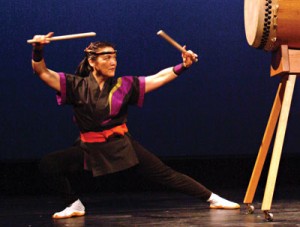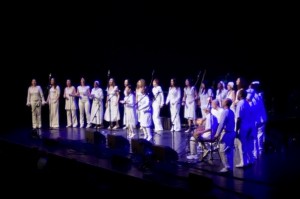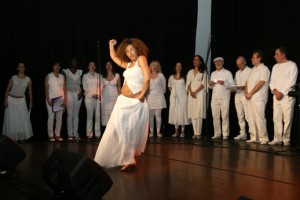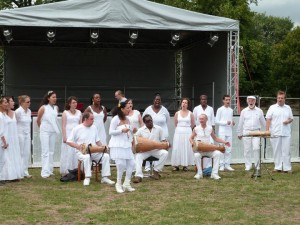To anyone living on the West Coast, taiko is a familiar fixture at folk festivals and at college events. But what about its history, especially in North America? In this Apsara guest post, Seattle composer and musician Byron Au Yong introduces the history of North American taiko and uses it as a lens for exploring the question: How can music be brought into a larger social, political, and spiritual sphere?

How can music be brought into a larger social, political, and spiritual sphere? By coining the word “TaikoPeace,” PJ Hirabayashi (artistic director emeritus of San Jose Taiko) attempts to reconnect with the core of playing music. Along with her husband Roy, Hirabayashi received the 2011 NEA National Heritage Fellowship. As co-founders of San Jose Taiko, they have contributed to the development of taiko music in the Bay Area and beyond.
For new audiences, a group taiko (or kumi-daiko) show may seem to be music passed down through many generations. In actuality, modern ensemble taiko performances started in the late 20th century. Tokyo-based jazz drummer Daihachi Oguchi founded Osuwa Daiko in 1951. While Japanese religious, theatrical, or village taiko may influence kumi-daiko performances, most taiko in North America is a form of new music or neo-folk performance generated by a vibrant, soul-searching community of amateur and professional musicians.
San Jose Taiko formed as part of the Asian American identity movement in 1973. As the third kumi-daiko group created outside of Japan, San Jose Taiko currently performs for over 100,000 people a year. In 1968, Seiichi Tanaka started San Francisco Taiko Dojo, which was the first kumi-daiko group in North America. The second group, Kinnara Taiko, started at  Senshin Buddhist Temple in South Central Los Angeles as a musical club that transitioned from a chant and gagaku (court music) group to a taiko group in 1969.
In less than 50 years, over 150 taiko groups outside of Japan have formed. Many follow the model of a community music-making group such as San Jose Taiko, a school such as Taiko Dojo, or a Buddhist temple activity such as Kinnara. Additionally, there are taiko professionals influenced by jazz pickup groups such as Russell Baba and Jeanne Mercer of Shasta Taiko, Kenny Endo Contemporary Ensemble in Hawai’i, and rock bands such as LOUD from Vancouver and On Ensemble from Los Angeles.
On Ensemble: Taiko & Turntable
Kumi-daiko groups have varying aesthetics, philosophies, and skill levels. Most taiko players are hobbyists. “TaikoPeace” provides a framework for personally engaging with music.
At the closing session of the 2011 North American Taiko Conference in August, Stephen Sano, professor and chair of the Department of Music at Stanford University, admonished the audience of nearly 800 taiko players and enthusiasts to consider “work” as a verb as well as a noun. Thinking only about the performance or the recording can dampen the spirit of working. His reminder to treat “work” as a verb allows taiko players to be process rather than goal oriented by focusing on the resonances and repercussions of making music.
During the discussion session “Taiko and Social Change,” curated by Alan Okada of New York City-based Soh Daiko, Hirabayashi referenced Karen Armstrong’s “Charter for Compassion.” Kenny Endo commented afterwards that taiko was an instrument historically used for war and that he supported Hirabayashi’s idea to use taiko for peace. With TaikoPeace, Hirabayashi continues her work delving into what it means to play taiko.
Taiko, the drum, has no inherent power. Rather, taiko musicians create meaning through their actions—whether it is rehearsing and performing within community groups or competing in Australia’s Got Talent 2011. Endo cautions that any taiko performance may be the first and last time to make an impression on an audience. Taiko can continue to be thought of as an instrument of war, rather than peace.
Australia’s Got Talent 2011
Misrepresentations of taiko continue to exist. Often presenters and even taiko players remark that this 50-year-old art form is thousands of years old. Perhaps a way to interpret TaikoPeace is as a continual reinvestigation of motives. TaikoPeace has the potential to become a space of compassion that supports multiple individual stories informed by a search for integrity within this art form.
Considering TaikoPeace, Hirabayashi wrote to me in a recent email: “TaikoPeace invites one to reflect on our own taiko journeys where we can see the impact of our thoughts, words, and actions. TaikoPeace is an initiative to become heart-centered. TaikoPeace is not playing to impress. TaikoPeace is playing to inspire.”
Hirabayashi continues to inspire with her recent transition from artistic director of San Jose Taiko to independent taiko artist. TaikoPeace strengthens the core of playing music to balance oneself as well as connect with the social, political and spiritual reasons that make taiko potent.
KTEH TV Profile of PJ and Roy Hirabayashi



